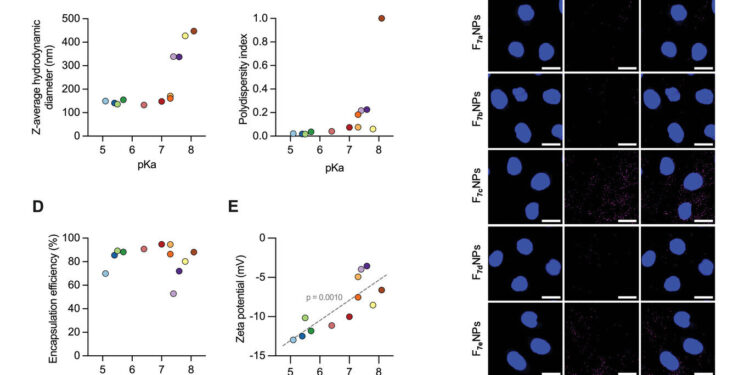Ionizable analogues of fulvestrant were formulated into nanoparticles with cholesterol, DSPC and DMG-PEG (molar ratio 50:38.5:10:1.5) to encapsulate siRNA (FXNP). Credit: Advanced materials (2024). DOI: 10.1002/adma.202403701
Researchers at the University of Toronto and its hospital partners have developed a method to co-deliver therapeutic RNA and powerful drugs directly into cells, which could lead to more effective treatment of diseases.
The research, recently published in the journal Advanced materialsexplores how ionizable drugs can be used to co-formulate small interfering RNAs (siRNAs) for more efficient intracellular delivery.
The team, which includes corresponding author Molly Shoichet, a professor in the Department of Chemical Engineering and Applied Chemistry in the Faculty of Applied Science and Engineering at the University of Toronto, specifically targeted drug-resistant cells by delivering a relevant siRNA. The siRNA was discovered by study co-author and collaborator David Cescon, a clinician scientist at the Princess Margaret Cancer Centre, University Health Network, and an associate professor in the Temerity School of Medicine at the University of Toronto.
“We found that our coformulation method not only potently delivered siRNA to cells, but also simultaneously delivered active ionizable drugs,” said lead author of the research, Kai Slaughter, a doctoral candidate in Shoichet’s lab.
“This could be a game-changer in treating complex diseases where targeting multiple pathways is beneficial, such as cancer and viral infections.”
siRNA is a powerful tool in medicine, capable of silencing specific disease-causing genes, but getting these molecules into cells without degrading them remains a major challenge. While recent innovations in ionizable lipid design have improved efficacy, traditional nanoparticle formulations are limited in the amount of small molecule drugs they can carry.
When therapeutic formulations are taken up by cells, small molecule drugs and siRNAs often become trapped in small compartments called endosomes, preventing them from reaching their target destination and reducing their effectiveness.
The research team discovered that combining siRNA with ionizable drugs (compounds that change charge depending on pH) improves the stability and efficiency of siRNA delivery inside cells, helping the siRNA and drug escape the endosome and reach their destination more efficiently. This new method uses the protective properties of lipids to shield the siRNA as it travels through the body and ensures that the RNA and drug are released together into target cells.
“One of the biggest hurdles in siRNA therapy has been getting these molecules where they need to go without losing their potency,” Shoichet says.
“Our approach using ionizable drugs as carriers marks a significant step forward in overcoming this obstacle, while showing how drugs and RNA can be delivered together in the same nanoparticle formulation.”
More information:
Kai V. Slaughter et al, Ionizable drugs enable intracellular delivery of coformulated siRNA, Advanced materials (2024). DOI: 10.1002/adma.202403701
Provided by the University of Toronto
Quote: Researchers develop new method to deliver RNA and drugs into cells (2024, September 16) retrieved September 17, 2024 from
This document is subject to copyright. Apart from any fair dealing for the purpose of private study or research, no part may be reproduced without written permission. The content is provided for informational purposes only.



